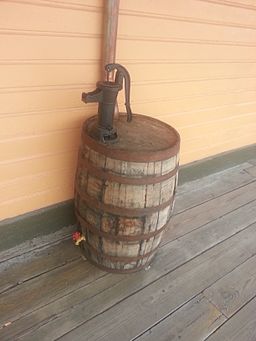
Credit: Donald Albury [CC BY-SA 3.0]
“I think it is somewhat much ado about little,” said Peter Mayer during our Connecting the Drops radio call-in show on water conservation. Mayer co-authored a new study Residential End Uses of Water, Volume 2, that’s lush with data on residential water use and conservation. Rainbarrels could save a user 1,000 to 1,500 gallons of water per year if used regularly, Mayer said. Although it sounds like a lot, 1,000 gallons likely costs only about $5 on your water bill, depending on your provider. Read about Denver Water’s recent changes to its rate structure here.

Peter Mayer in the KGNU studio, discussing water conservation with host Maeve Conran.
But that’s not to say that rainwater harvesting is a bad investment or an unimportant move for the state. “The symbolic value is very good,” Mayer said. “Anything that gets people thinking about how to use water efficiently and how not to waste it is very much a positive thing.” Rainwater harvesting may increase overall water awareness for residential users, leading to an increased conservation ethic.
At the same time, these systems can have a stormwater impact. “I think that the potential benefits from stormwater management may be at least as significant as the water conservation potential,” Mayer said.
People tend to connect downspouts to their gutter systems and direct those straight into their driveways so water washes off roofs, down driveways and streets and into city gutters, collecting pollutants along the way, said April Long, stormwater manager for the City of Aspen. Rainwater harvesting allows that water to be captured and gradually discharged onto lawns and gardens which naturally filter out pollutants, improving overall water quality.
 A rainwater harvesting system under special permit was constructed and operated at the Denver Green School as a research project that began in 2012. From CFWE’s new Citizen’s Guide to Colorado Water Conservation:
A rainwater harvesting system under special permit was constructed and operated at the Denver Green School as a research project that began in 2012. From CFWE’s new Citizen’s Guide to Colorado Water Conservation:
The unique system was constructed with stormwater management in mind. With a real-time connection to the National Oceanic and Atmospheric Administration weather forecast, any stored water drains prior to a storm so that the system’s full capacity is available for rainwater capture. Data collected at the Denver Green School site between 2012 and 2014 show a reduction in the volume of stormwater runoff of 88 percent on average per event. By reducing the volume of stormwater exiting the site, the system reduces pollutant loading in nearby streams as well as erosion in the stream associated with increased stormwater runoff.
The Denver Green School’s project also showed that rainwater harvesting can provide a real reduction in irrigation demand for sites with a large rooftop-to-irrigated-landscape-area ratio. At the school, 81 percent of irrigation water used was rainwater.
Read more about this project and effective conservation measures, regulations, incentives and more in the new Citizen’s Guide.

 Print
Print
Reblogged this on Coyote Gulch.
I agree about the “symbolic value” completely. Nothing like watching the water level drop in the barrel.
My little rural fire department had a benefit garage sale on Memorial Day weekend. I donated four large plastic barrels that I did not use anymore. We put them out with a sign, “Rain Barrels — Now Legal in Colorado,” and they sold quickly.